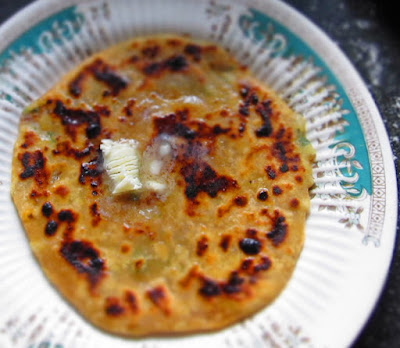When it rains, I like my meals piping hot and savoury.
True, it hasn't been raining as much as July should, but my tastebuds expect fried goodness this time of the year, so the same rice and daal and curries that were delicious just last month seem bland and pointless and vaguely disheartening now.
To soothe them and be nice to myself, I thought I'd make alooparatha. But, my chief complaint about aloo paratha is that it isn't quite as crispy or deep-fried or yummy as my favourite form of the stuffed Indian flatbread -- pooris. Now, I know people say potato is a difficult stuffing to handle when rolling the stuffed pockets of dough out, which is why one should stick to the safer paratha option, but I wasn't going to let a little thing like received wisdom stop me, was I? Not me!
So I didn't, and though the rolling out did take some patience, I had two lovely, lovely golden pooris to prove my point. Here's the picturebook :-)
True, it hasn't been raining as much as July should, but my tastebuds expect fried goodness this time of the year, so the same rice and daal and curries that were delicious just last month seem bland and pointless and vaguely disheartening now.
To soothe them and be nice to myself, I thought I'd make alooparatha. But, my chief complaint about aloo paratha is that it isn't quite as crispy or deep-fried or yummy as my favourite form of the stuffed Indian flatbread -- pooris. Now, I know people say potato is a difficult stuffing to handle when rolling the stuffed pockets of dough out, which is why one should stick to the safer paratha option, but I wasn't going to let a little thing like received wisdom stop me, was I? Not me!
So I didn't, and though the rolling out did take some patience, I had two lovely, lovely golden pooris to prove my point. Here's the picturebook :-)
Boiled and skinned potatoes.
Seasoned with chopped onions, coriander leaves, salt and pepper. One can add more herbs if one likes, and perhaps some ginger, but I stick to the basics.
Mash it all together.
Roll little bits in between your palms to make smooth potato balls.
Put these inside thick cups of dough, made by mixing whole wheat flour, a little white oil, salt, touch of sugar, and slightly warm water.
Pull up the sides of the cups and seal them together at the top. Now dust it in flour and roll it out carefully.
The rolling needn't be that careful if you're making parathas. Shallow-frying doesn't need a smooth surface.
But deep frying does. Hence the perfectly shaped and carefully rolled-out pooris.
Touch of butter, for autheticity.
A little for the pooris too :-)




























